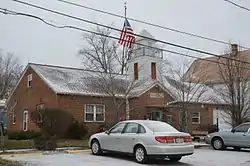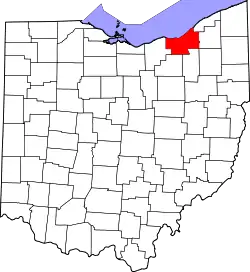Linndale, Ohio
Linndale is the smallest village in Cuyahoga County, Ohio, United States. It is landlocked, surrounded by the cities of Cleveland and Brooklyn. According to the 2010 census, the village achieved the second highest growth rate in Cuyahoga County: 53% as the population increased from 117 to 179, although the last house was built in 1968 and there are only 37 residential addresses.[6]
Linndale, Ohio | |
|---|---|
 Village Hall | |
 Location in Cuyahoga County and the state of Ohio. | |
| Coordinates: 41°26′39″N 81°46′3″W | |
| Country | United States |
| State | Ohio |
| County | Cuyahoga |
| Government | |
| • Mayor | Ashlee McLaughlin |
| Area | |
| • Total | 0.07 sq mi (0.19 km2) |
| • Land | 0.07 sq mi (0.19 km2) |
| • Water | 0.00 sq mi (0.00 km2) |
| Elevation | 758 ft (231 m) |
| Population | |
| • Total | 179 |
| • Estimate (2019)[4] | 169 |
| • Density | 2,315.07/sq mi (897.48/km2) |
| Time zone | UTC-5 (Eastern (EST)) |
| • Summer (DST) | UTC-4 (EDT) |
| ZIP code | 44135 |
| Area code(s) | 216 |
| FIPS code | 39-43918[5] |
| GNIS feature ID | 1065002[2] |
Geography
Linndale is located at 41°26′39″N 81°46′3″W (41.444050, -81.767476).[7]
According to the United States Census Bureau, the village has a total area of 0.08 square miles (0.21 km2), all land.[8] The southeast border is along the municipal limits of Brooklyn; the remainder of Linndale is surrounded by Cleveland.
Demographics
| Historical population | |||
|---|---|---|---|
| Census | Pop. | %± | |
| 1910 | 512 | — | |
| 1920 | 490 | −4.3% | |
| 1930 | 400 | −18.4% | |
| 1940 | 445 | 11.3% | |
| 1950 | 399 | −10.3% | |
| 1960 | 381 | −4.5% | |
| 1970 | 169 | −55.6% | |
| 1980 | 129 | −23.7% | |
| 1990 | 159 | 23.3% | |
| 2000 | 117 | −26.4% | |
| 2010 | 179 | 53.0% | |
| 2019 (est.) | 169 | [4] | −5.6% |
| U.S. Decennial Census[9] | |||
2010 census
As of the census[3] of 2010, there were 179 people, 66 households, and 38 families residing in the village. The population density was 2,237.5 inhabitants per square mile (863.9/km2). There were 75 housing units at an average density of 937.5 per square mile (362.0/km2). The racial makeup of the village was 65.9% White, 27.9% African American, 1.7% Pacific Islander, and 4.5% from other races. Hispanic or Latino of any race were 17.3% of the population.
There were 66 households, of which 37.9% had children under the age of 18 living with them, 19.7% were married couples living together, 28.8% had a female householder with no husband present, 9.1% had a male householder with no wife present, and 42.4% were non-families. 27.3% of all households were made up of individuals, and 4.5% had someone living alone who was 65 years of age or older. The average household size was 2.71 and the average family size was 3.24.
The median age in the village was 35.1 years. 26.3% of residents were under the age of 18; 8.4% were between the ages of 18 and 24; 35.2% were from 25 to 44; 22.9% were from 45 to 64; and 7.3% were 65 years of age or older. The gender makeup of the village was 48.6% male and 51.4% female.
2000 census
As of the census[5] of 2000, there were 117 people, 57 households, and 29 families residing in the village. The population density was 1,332.8 people per square mile (501.9/km2). There were 71 housing units at an average density of 808.8 per square mile (304.6/km2). The racial makeup of the village was 68.38% White, 18.80% African American, 0.85% Native American, 4.27% from other races, and 7.69% from two or more races. Hispanic or Latino of any race were 7.69% of the population.
There were 57 households, out of which 24.6% had children under the age of 18 living with them, 29.8% were married couples living together, 15.8% had a female householder with no husband present, and 49.1% were non-families. 43.9% of all households were made up of individuals, and 10.5% had someone living alone who was 65 years of age or older. The average household size was 2.05 and the average family size was 2.93.
In the village, the population was spread out, with 24.8% under the age of 18, 6.0% from 18 to 24, 42.7% from 25 to 44, 15.4% from 45 to 64, and 11.1% who were 65 years of age or older. The median age was 34 years. For every 100 females there were 101.7 males. For every 100 females age 18 and over, there were 79.6 males.
The median income for a household in the village was $21,500, and the median income for a family was $30,625. Males had a median income of $33,750 versus $25,893 for females. The per capita income for the village was $17,912. There were 21.7% of families and 15.7% of the population living below the poverty line, including 19.2% of under eighteens and 10.0% of those over 64.
Controversy
Linndale, often called a speed trap,[6][10] had for many years the busiest, on a per-capita basis, Mayor's Court in the State of Ohio.[11][12] The village in the past has successfully defended its legal right to enforce the 60 mph speed limit on the 422 yards (386 m) of Interstate 71 within its jurisdiction under the "Home Rule" provisions of the state constitution.[10][13] The combination of traffic enforcement and Mayor's Court has provided 80% of Linndale's one million dollar annual budget, and underwritten its four full-time and ten part-time police officers.[14]
On December 20, 2012, Governor John Kasich signed a bill[15] into law effective March 22, 2013 which dissolved Linndale's Mayor's Court.[16] A sergeant in the Linndale police department stated that traffic cases would subsequently be handled by nearby Parma.[17]
In response to decreasing revenue, Linndale has installed speed cameras on its most heavily traveled non-interstate road Memphis Avenue[18] and is processing some traffic violations locally instead of relying on Parma Municipal Court.[19] Another attempt to increase revenue with a proposed increase in the village income tax from 2% to 2.5% failed in an 8-12 referendum vote.[20]
In October 2017, Linndale was featured on the internationally syndicated NPR show This American Life in episode 629 entitled Expect Delays.[21]
References
- "2019 U.S. Gazetteer Files". United States Census Bureau. Retrieved July 28, 2020.
- "US Board on Geographic Names". United States Geological Survey. 2007-10-25. Retrieved 2008-01-31.
- "U.S. Census website". United States Census Bureau. Retrieved 2013-01-06.
- "Population and Housing Unit Estimates". Retrieved May 21, 2020.
- "U.S. Census website". United States Census Bureau. Retrieved 2008-01-31.
- "Greetings From Linndale". Cleveland Magazine. August 2011. Retrieved 2012-02-19.
Cuyahoga County's tiniest town is five blocks long and two blocks wide. It has eight streets, 37 residential addresses [and] Linndale has earned a new distinction: Cuyahoga County's second-fastest-growing community. That's surprising, considering no one's built a house since 1968 in this town of something less than 200 people...Linndale's 53 percent population spike is pretty strange, especially when you look at the results more closely... Nine residents supposedly moved into an industrial zone but can't be found. The census counts one block as part of Linndale when it's really in Cleveland.
- "US Gazetteer files: 2010, 2000, and 1990". United States Census Bureau. 2011-02-12. Retrieved 2011-04-23.
- "US Gazetteer files 2010". United States Census Bureau. Archived from the original on 2012-07-02. Retrieved 2013-01-06.
- "Census of Population and Housing". Census.gov. Retrieved June 4, 2015.
- "Linndale speed trap survives yet another legislator's attempt to flatten its tires". The Plain Dealer. June 20, 2011. Retrieved 2012-02-19.
Two things we ought to know by now about the tiny village of Linndale: Drivers can't speed through its 422 yards of Interstate 71 without getting a ticket, and state legislators, no matter how hard they try, can't put the brakes on Linndale's prolific traffic cops.
- Conley, Justin; McKinsey, Rebecca (July 22, 2012). "Ohio's mayor's courts, big business". Columbus Dispatch. Retrieved August 23, 2012.
(Linndale's) mayor's court handled about 4,200 citations in 2011, more than 90 percent of which were traffic tickets.
- Michael K. McIntyre (July 23, 2008). "Linndale Mayor's Court leads in per capita traffic cases". The Plain Dealer. Retrieved 2012-02-19.
In the Ohio Supreme Court's recently released 2007 report on Ohio's 355 mayor's courts, Linndale tops the per-capita list with 4,062 cases per 100 people. With only 117 residents – and police who are quick draws with the pen – it wasn't even close. No. 2 in per-capita cases was Hanging Rock, on the Ohio River in south central Ohio, with 531 per 100 residents.
- Supreme Court of Ohio (March 24, 1999). "Linndale v. State (1999)" (PDF). Supreme Court of Ohio. Retrieved 2012-02-19.
The Ohio General Assembly enacted R.C. 4549.17 in 1994. The statute prohibits local law enforcement officers from issuing speeding and excess weight citations on interstate freeways when [certain conditions exist; however the Court finds that] R.C. 4549.17 is not a general law, it unconstitutionally impinges on the home-rule powers of the affected municipalities.
- "Greetings From Linndale". Cleveland Magazine. August 2011. Retrieved 2012-02-19.
Linndale has four full-time police officers and 10 part-time cops. Their work on I-71 and Memphis Avenue generates the tickets and fines that keep the town going...About $800,000 a year in fines flow through Linndale's court, swelling the village budget to $1 million.
- Sub. House Bill 606, 129th General Assembly
- State of Ohio, Office of the Governor (2012-12-20). "Kasich Signs 42 Bills into Law (press release)" (PDF). Retrieved 2013-01-10.
- Beres, Tom (2013-03-21). "Linndale: Mayor's Court Dead but Speed Trap Is Not". WKYC-TV. Retrieved 2013-03-22.
- http://www.cleveland.com/tipoff/index.ssf/2013/08/linndales_highway_speed_trap_i.html
- http://www.cleveland.com/metro/index.ssf/2013/09/linndale_village_charter.html
- http://www.cleveland.com/tipoff/index.ssf/2013/11/linndale_income_tax_hike_draws.html
- https://www.thisamericanlife.org/629/expect-delays
External links
- "Lindale electoral map" (PDF). Cuyahoga County Board of Elections. 2004-04-07. Retrieved 2011-06-17.
- Video of I-71 through Linndale (2:25-2:27)
